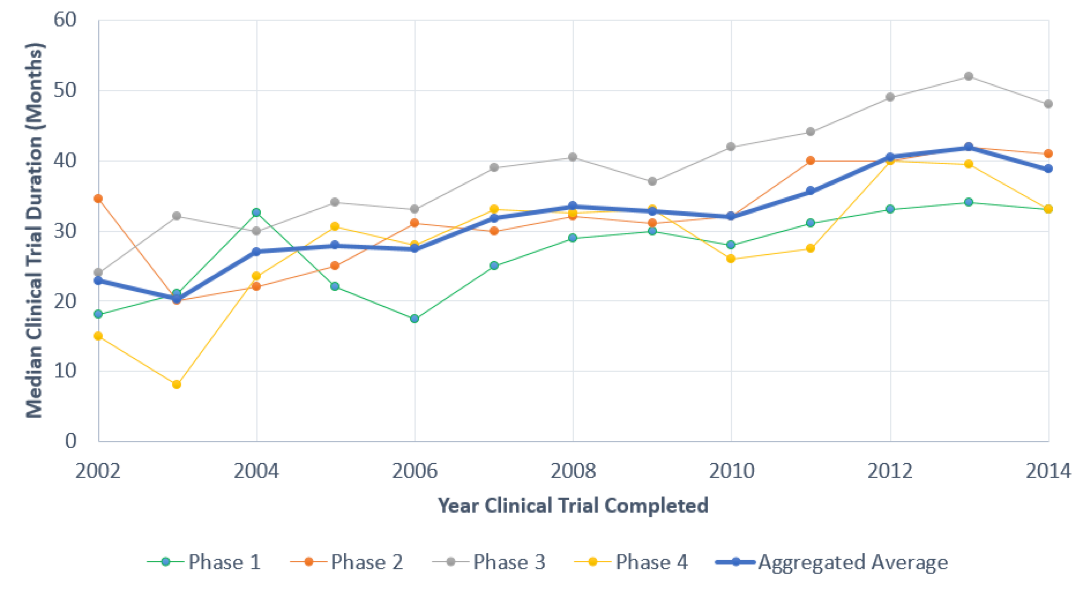Why Are Cancer Clinical Trials Increasing in Duration?
An article recently appeared in Applied Clinical Trials, which indicated that oncology trials are taking longer to complete, and the article suggested that the duration of oncology clinical trials in certain phases increased by one year to one and a half years.1 Moreover, the article delineates that ameliorations in trial duration were most likely a result of increasing protocol complexi
An article recently appeared in Applied Clinical Trials, which indicated that oncology trials are taking longer to complete, and the article suggested that the duration of oncology clinical trials in certain phases increased by one year to one and a half years.1 Moreover, the article delineates that ameliorations in trial duration were most likely a result of increasing protocol complexity/trial design, numerous endpoints, increases in the number of subjects required, and longer treatment periods.
However, industry experts have a different viewpoint as to why these trials are increasing in duration. This article will evaluate the duration of oncology clinical trials from an aggregated standpoint, using the Karmadata Database, and will elaborate on different perspectives as to why oncology studies are increasing in duration.
Oncology Clinical Trials are Increasing in Duration
In order to confirm findings from the aforementioned article, we evaluated median oncology industry sponsored clinical trial duration in all oncology disease modalities. We leveraged Karmadata to cull www.clinicaltrials.gov aggregated data from 4,849 cancer clinical trials from 2002-2014, and findings are illustrated in Figure 1.
Figure 1: Median Trial Duration: Oncology Trials (Source: Karmadata)

From an aggregated standpoint, median oncology clinical trial duration increased by 69% from 2002-2014, an average increase of 16 months. Phase I – IV cancer trial duration increased by 83% (Phase I), 19% (Phase II), 100% (Phase III), and 120% (Phase IV), respectively*.
Figure 2 further dissects this data by categorizing oncology trial duration by a few disease modalities.
Figure 2: Trendline Analysis of Oncology Trial Duration by Disease (Source: Karmadata)

Figure 2 illustrates that the duration of colon cancer trials increased the most, by 178%, whereas blood (60%), breast (50%), lung (42%), and solid tumors (22%) exhibited similar trends, accordingly*.
Research Leading Towards Why Cancer Trials are Increasing in Duration
According to the literature, protocols are becoming more complex, more data is required, and subject enrollment timelines are, correspondingly, delayed as a result of increasing protocol complexity.2 For example, a study conducted on aggregated clinical trials in a variety of phases suggests that procedural frequency grew by 8.7% on an annual basis, study subject questionnaires increased significantly in Phase III and IV studies, and the average number of inclusion criteria skyrocketed by more than three times.2 Additionally, study site work burden grew by 10% on an annual basis, and the median number of adverse events increased by 122%.2
Other studies evaluating Phase III protocols from 2002-2012 suggest that the total number of study endpoints has surged by 86%, procedures have risen by 58%, and eligibility criteria grew by 61%, number of investigative sites have increased by 58%, yet, the number of patients randomized declined by 18%.3
However, We May Be Overlooking a Critical Factor: Antiquated Endpoint Design
Peter Schiemann of Widler & Schiemann, Ltd. will elaborate on another perspective regarding why oncology trials are increasing in duration. The reason why oncology trials in particular are increasing in duration is because standard of care (SOC) treatment options are so good at prolonging life, however, regulators and payers still require that an oncology study’s primary endpoint focus on patient death.
To demonstrate, a multiple myeloma diagnosis used to be a death sentence before novel treatments underwent clinical trials; and patients that have undergone those trials in are still living today. So, now that these drugs have become the SOC, newer oncology therapies are now experiencing patient populations that are living longer compared to before, or are not dying; and this factor is, subsequently, increasing oncology trial duration for studies that focus on death as the primary endpoint.
How Can Regulators, Payers and the Biopharmaceutical Industry Change?
Regulators, payers and the biopharmaceutical industry need to rethink oncology trial endpoint design to focus on demonstrating improvements and value depending on the disease modality; especially in earlier cancer settings where there are now a significant number of patient alive 5 years after diagnosis such as breast cancer or colon cancer.
Both regulators and payers need to exercise flexibility in endpoint requirements; maintaining the status quo would hinder novel oncology drug development, as these drugs will experience a prolongation to market and thus significantly slow down innovation in a therapeutic area with continuing high unmet need. Moreover, the biopharmaceutical industry needs to think very carefully about their study design, in order to off set the longer duration by reducing complexity and focusing on data collection that really matters.
References:
[1] http://www.appliedclinicaltrialsonline.com/oncology-trials-are-taking-longer
[2] http://csdd.tufts.edu/_documents/www/2816Getz.pdf
[3] Tufts CSDD, Medidata
Additional Readings:
http://www.appliedclinicaltrialsonline.com/kadmon-ceo-discusses-biopharma-innovation
http://www.afmr.org/multimedia/2009/Clinical-Research-Conference/jim200301.pdf
http://www.ema.europa.eu/ema/index.jsp?curl=pages/regulation/general/general_content_000601.jsp&mid=WC0b01ac05807d58ce
* Not statistically significant